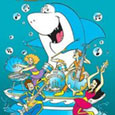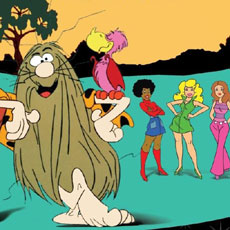Hanna-Barbera (1969), Warner Home Video (May 10, 2005), 3 discs, 459 mins plus supplements, 1.33:1 original full frame ratio, Dolby Digital Mono, Rated G, Retail: $34.98
Storyboard:
Vile Dick Dastardly and his Vulture Squadron, including the sniggering dog Muttley, attempt to stop a carrier pigeon from delivering his messages.
The Sweatbox Review:
1969 saw two significant events for Hanna-Barbera: the debut of Scooby Doo, Where Are You?, and the advent of the Hanna-Barbera spin-off. Scooby became quite famous for spawning numerous spin-off shows later on, of course, but the H-B spin-off machine first got going when network programmer Fred Silverman asked Bill and Joe to create two shows using characters from the previous season’s Saturday morning hit Wacky Races. For one of these shows, a series already in development was simply re-jiggered with Wacky Races “bad guys”.

Stop The Pigeon was originally going to feature a plump WWI flying ace called “The Baron”, and his dog, but instead Dick Dastardly and Muttley were substituted. It worked well, but was odd in a way, since the show seemed to have a World War I setting whereas Wacky Races was set in the present. Nevertheless, the personalities of the two characters suited the series perfectly. This was a rare show in which the lead characters were undoubtedly the villains, so the characters had to have a certain amount of appeal in order to keep viewers interested.
In the re-titled Dastardly & Muttley In Their Flying Machines, Dick Dastardly headed up the Vulture Squadron, an inept flying team whose mission it was to stop a bird messenger, Yankee Doodle Pigeon (appropriately colored red, white, and blue) before he could, uh… well, it was never really explained why they needed to stop him. Assumedly, Yankee Doodle Pigeon was a messenger who represented the best interests of America, while the Vulture Squadron worked for a hostile foreign power. Dastardly actually reported to his never seen but often heard superior, only ever referred to as “The General”. Muttley was Dastardly’s “assistant, although just as in Wacky Races, Muttley seems to only be in this for his own amusement. Muttley was given two new traits for this show: he could spin his tail in order to fly (which came in handy since Dick often needed to be caught in freefall), and Muttley was always looking for a medal for his deeds— generally before he performed. The others in the Vulture Squadron were Klunk, who was a nutty inventor type whose speech was punctuated by sound effects, and a meek fellow named Zilly.

A typical show featured the Squadron coming up with a new scheme to catch the pigeon, usually involving a new invention of Klunk’s. Without fail, this would be a flying machine of some type, carrying any number of pairs of wings, and often outfitted with such preposterous devices as a super-size vacuum cleaner or mechanical hands. Given that the Squadron folks were the bad guys, they naturally had to fail every time, often in a humiliating way. Typically, they would receive a phone call from the General, perhaps in mid-crash, reaming them out. Like Wacky Races, Dastardly and Muttley was a gag cartoon, with only the barest of plots; and each episode had the same story with only modest changes from show to show. One episode would have two of these regular stories, as well as pair of a brief “Wing Dings” gag shorts that were little more than interstitials (these had the show’s characters, but without the plane/pigeon plot) and “Magnificent Muttley”, which saw the popular snickering canine daydreaming about himself in various heroic roles. “Magnificent Muttley” demonstrated the show’s only link to Wacky Races, as the Mean Machine was often shown in one way or another.
So how does the show stack up now? Well, it’s like watching the Road Runner and Coyote, but with duller backgrounds, weaker gags, and poorer drawing. This wasn’t the nadir of Hanna-Barbera animation, but it was now in sight. Everyone has their favorites from their childhood, but most would have to admit that from here on the next decade would see more than its share of clunkers from Hanna-Barbera. When one considers that H-B had six different series in production in 1969, one can see how the quality happened to start slipping. Dastardly & Muttley In Their Flying Machines has its charms, but does little to stand out from the crowd.
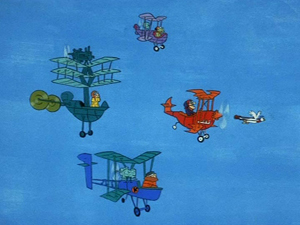
I can’t totally dismiss the show, however. The modest humor still manages to tickle part of my funny bone, largely due to the voice talents of Paul Winchell (Dastardly and the General) and Don Messick (everyone else). Dastardly is a hoot, spouting his “Drat and double drat”, and of course there’s Muttley’s wheezing snicker as he “accidentally” lets Dick fall to the ground or suffer similar physical violence.
As always, I find refreshing to watch an older show that is relatively “pure”— it isn’t trying to be either too hip or a toy tie-in (although plenty of merchandising would come). The backgrounds couldn’t be drabber, as what seems to be the EXACT SAME UGLY SKY BACKGROUND is used ad infinitum throughout the series, but the design work of Jerry Eisenberg and Iwao Takamoto on the planes and characters is consistently fun. And then there’s that annoyingly catchy theme music that will rattle in my head for the next month!
The next time that we saw Dastardly and Muttley would be in 1977’s Scooby’s All-Star Laff-A-Lympics. They were re-designed and renamed The Dread Baron and Mumbly, but fans knew who they really were. The reason for not simply using the original monikers is not certain, but I do wonder if Dick’s replacement of a character named “The Baron” from the original Stop The Pigeon show proposal inspired the new name.
This set has all seventeen episodes, on three single-sided, dual-layered discs.

Is This Thing Loaded?
The show may not be all that great, but everything else about this release says “class”. The animated menus are a nice start, and there are also two Audio Commentaries. Designers Iwao Takamoto and Jerry Eisenberg, and two other former Hanna-Barbera staff members named Scott Awley and Scott Jeralds, contribute their thoughts on episodes 11 and 15. The first commentary talks much about designing the show and the show’s background. The second commentary hears them discussing the show’s merchandising, the voice artists, and other aspects of creating the show.

Disc One also has The Vulture Squadron’s Greatest Misses (7:36), a fairly useless collection of clips from the show. (You may select individual sections, too, featuring Dastardly, Muttley, Planes, Klunk and Zilly, or General Calls.) Disc Two has the more meaty Dastardly And Muttley’s Spin-Offs (4:47), which is a bit of a misnomer. This featurette only covers Dastardly& Muttley In Their Flying Machines, and nothing more. It’s a brief but nice overview of the show, even if the material is just recycled from the Wacky Races set. Because the material is taken from the second featurette of another set, the speakers are not even identified here. Much of what is said here can also be gleaned from simply watching the show itself, but it is neat to see the designers of the show on-camera, and we even see production art from the original Stop The Pigeon proposal.

Disc Three, in addition to the second commentary, also has some Trailers for previous Warner Home Video animation sets. Sorry, no previews of oncoming titles here.
Case Study:
The package here is another winner from Warner Home Video. You couldn’t ask for a more beautiful set, with colorful graphics adorning every part of the foldout digipack, the discs, and the clear outer case. As with the past couple of Hanna-Barbera releases, the “Golden Collection” tag has been dropped in favor of “Classic Collection”, and the habit of numbering a release of a complete series has been wisely dropped. Inside the package, one will find a “collectible cell replica”, albeit a naturally miniature one. The inside of the digipack even lists all the segments of each show (which are not chapter-encoded), in addition to the bonus features
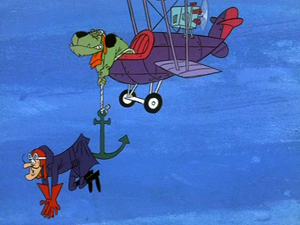
Ink And Paint:
The image here is not quite as soft as on the Wacky Racesset, but the other physical problems remain. These are mainly related to the source material, though, and much of it was present when the show was first televised— smudges and dust, in addition to what is likely some age-related dirt. The compression work looks nearly perfect to me, though— minimal edge enhancement, and no shimmering.
Scratch Tracks:
The mono soundtrack is fine, sounding as good as what is possible. English, French, and Spanish tracks are available, along with subtitles in the same languages. The range of voice talent is much more limited here than in Wacky Races, since only two actors voiced all the roles, but as I mentioned they did do wonderful work.
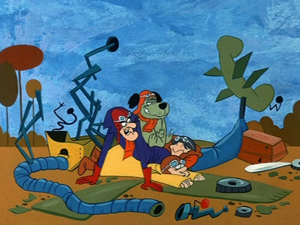
Final Cut:
I await volumes of more celebrated shows, but it is nice to see Warner keep up the production of quality sets. They may have been criticized some for production issues on a couple of their classic cartoon sets, but overall they are doing more than any studio outside of Disney in regards to their animation releases. This particular purchase decision will depend on how much you adore Hanna-Barbera even in their weaker moments. Personally, I was happy to make a purchase of this in order to voice my support for this type of product.
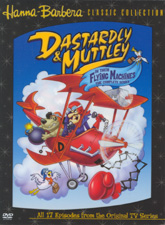 | ||
 |








